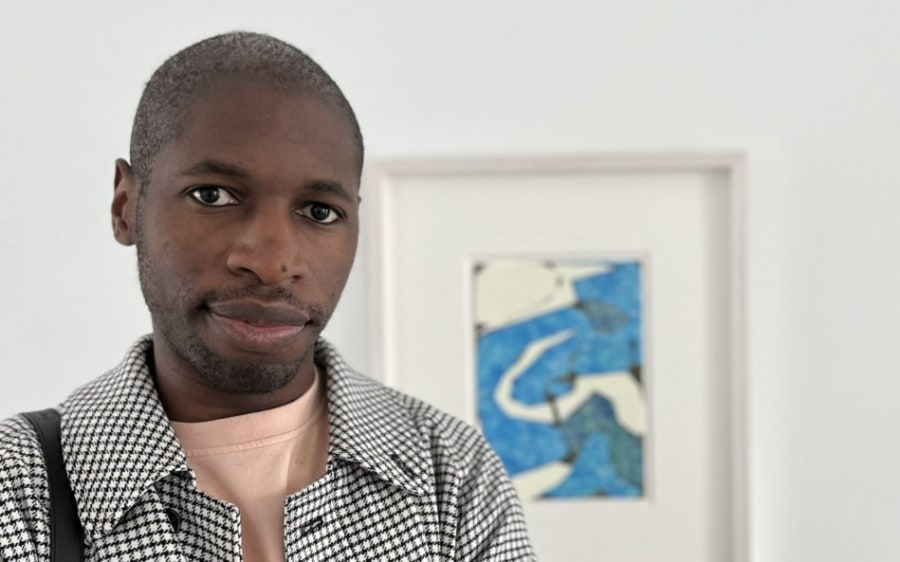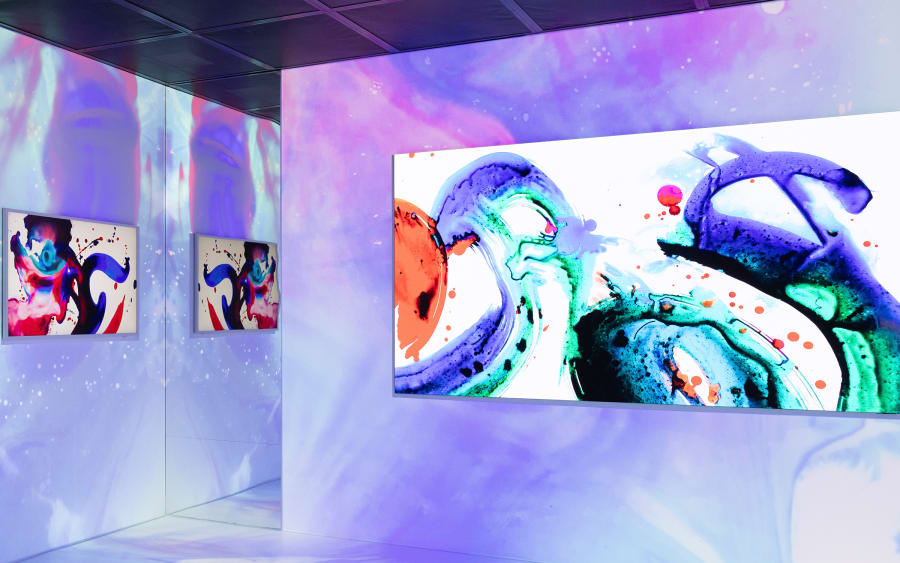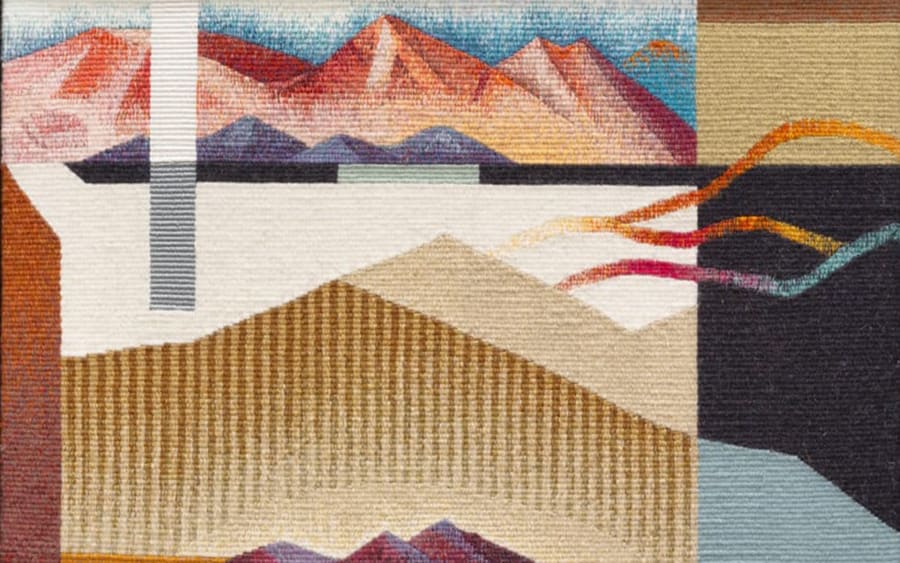The French artist William Mapan has collaborated with Art Basel to launch a collection of one-of-a-kind generative prints during this yearʼs Paris edition of the fair. Below, he reflects on his background as a software developer, the relationship between coding and painting in his practice, and the future of digital art in the age of artificial intelligence.
Before your first exhibition, in 2022, you worked in software development. How did you make the transition to a career as an artist?
The official term was creative engineer or developer. I did everything from pitching ideas to designing 3D elements to developing the website or video games. This job was the best compromise between having a creative practice and paid work. Working with big brands, you get budgets to develop crazy ideas. That was cool.
Previously, I had studied animation, media art, and software engineering. I graduated from Gobelins, l’école de l’image in Paris in 2012. From there, I just started keeping a creative practice going on the side. Around 2016 was the first time I encountered the term ʻgenerative art,ʼ at an exhibition in Paris. I was like, ʻOh, there is something actually going on here.ʼ
It was around Covid that I started thinking about prioritizing my art practice. Covid did that for a lot of people – when you’re isolated, you start reflecting, asking yourself questions, thinking about how you’re spending your time. And then the NFT train arrived. It was good timing, because the world was suddenly interested in digital art and there was a way to monetize what I was already doing.
You have a hybrid practice, working with both code and algorithms and with paint. Why are you drawn to these mediums?
Before I started coding, from around the age of 20, I was painting. I wasn’t so into computers. I was much more into being outside and making stuff with my hands. And then at school I discovered coding and I was like, ʻOh, maybe I can find a way to mix both.ʼ I would create a texture using paint and then scan it and apply it digitally, or make a 3D model and paint it by hand.
Curiosity is my main driver – to explore what’s unknown and invisible. I like to explain generative art, for me at least, as a way to create and explore infinite universes. The programming language is not important, but usually it’s JavaScript, because then I can share things on the web. I don’t really use any open-source libraries – they’re amazing but over 15 years of coding I’ve developed my own toolbox.
Because there are all these components, it took some time to develop my abilities. It took seven or eight years of practice, with both coding and painting, before I felt I was at a point where I could achieve what I wanted. Iʼm still trying to find common ground as I navigate both worlds. I try not to dwell too much in one or the other.
When you embark on a new work, is there a process that you follow, or does it differ each time?
I would say the conceptual phase is usually the same, although it’s more of a routine. I sketch every day – but the sketching can be anything. It could be sketching by hand in a notebook, or on a computer with code. Sometimes I use a plotter machine to render the code drawings. I like to navigate between the computer and the studio and then usually some idea emerges through that, because I think the medium drives your ideas.
With code, I usually make between 100 and 500 sketches a day, because you can just iterate. Often nobody will see these sketches, and it might not seem worth it, but it just keeps the ideas rolling.
At Art Basel Paris in October, you’re launching a new collection of 250 generative prints, each unique and 1 of 1. Some related paintings will also be exhibited in a group show in Paris, ʻCode + Matterʼ. Can you tell us about these works?
Usually when I do generative work, I have very bright colors. But this time I wanted to incorporate the colors of the natural world, to try to make something that didn’t look so digital. I took photographs in various locations and used the shapes and colors of the landscapes as a reference for the generative algorithm.
The paintings are based on the generative compositions, a way of bringing together the two sides of my practice. In both, if you step back, you will see a landscape – beaches, mountains, and so on. But if you come close, everything is a mess.
Where do you go for inspiration – traditional art, digital art, or elsewhere?
I have so many influences, it’s super hard. I would say, Matisse and Etel Adnan for the boldness of their shapes, the application of paint on the surface, and these vibrant but harmonious colors – they are inspiring to see. Also traditional painters like Sorolla or Sargent, or even the Impressionists, who applied color in such subtle ways.
On the generative side, Matt DesLauriers is a friend from way before NFTs – we met around 2015. I admire him for all the open-source tools he provides to the community. His work is inspiring too, showing you what is possible with computers. Zach Lieberman has also been very influential with his idea of an ʻeveryday practiceʼ – sketching something everyday.
Let’s talk about the future: what your plans are, but also your thoughts on the future of digital art. What role might AI play?
AI can be great for artists because it’s a way to create and expand those universes I was talking about. But I’m not so optimistic about the consequences of relying on AI on a day-to-day basis.
In my own work, I also don’t want to use AI too much. Maybe for boring tasks, like exporting thousands of images and putting them in folders, but not for creative coding. The more you use AI, the more you lose control over your algorithm, which is super important when code is your artistic medium. When I code, it enables me to see things in a different way. If we rely too much on AI, I fear we might lose that.
Iconic Moments and Art Basel will present an exclusive collaboration for Art Basel Paris with Paris-based artist William Mapan: a limited edition of 250 custom-designed Art Cards. Each card is embedded with an NFC chip that enables collectors to claim a unique digital artwork from Mapan’s latest algorithmic release and unlock the opportunity to acquire a corresponding museum-quality print, shipped directly to the collector.
Gabrielle Schwarz is a freelance writer and editor specializing in contemporary art and culture. She lives in the U.K.
Caption for header image: A work from the series Superpositions.
Published on September 30, 2025.


